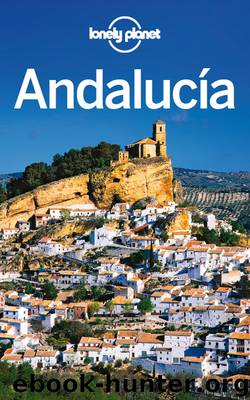Andalucía Travel Guide by Lonely Planet

Author:Lonely Planet
Language: eng
Format: epub
Publisher: Lonely Planet
Sights
The town’s catalogue of elegant architecture has earned it a reputation as the capital of Cordoban baroque. Northeast of the central Plaza de la Constitución, the narrow lanes of the Barrio de La Villa (the old Arab quarter) all converge on the handsome Balcón de Aldarve with its elevated promenade and magnificent views over the Río Salado.
CHURCH Parroquia de la Asunción
(Plaza Santa Ana 1; admission €3; 10.30am-1.30pm Tue-Sun) At the center of the Barrio de la Villa stands this church, the chapel and ornate retablo (retable) of which represent a high point in Andalucian baroque and are now considered national monuments. Don’t miss the chapel of El Sagrario (the sacristy), in which a whirl of frothy white stuccowork surges upwards to a beautiful cupola.
HISTORIC BUILDING Carnicerías Reales
(Royal Slaughterhouses; Calle Santiago; admission incl admission to Castillo €1; 11am-1.30pm daily & 4.30-6.30pm Tue-Sat) This well-preserved, 16th-century slaughterhouse has an enclosed patio and a wonderful stone staircase; exhibitions of paintings are often held here.
CASTLE Castillo de Priego de Córdoba
(Plaza de Abad Palomino; admission incl admission to Carnicerías Reales €1; 11am-1.30pm daily & 4.30-6.30pm Tue-Sat) The rectilinear towers of Priego’s castle stand proudly on the northern side of the Plaza de Abad Palomino. Originally an Islamic fortress, it was thoroughly remodeled by the new Christian overlords between the 13th and 15th centuries. Dozens of stone catapult balls from those belligerent times lie scattered around the courtyard.
Clamber up the tower for aerial views of the white city.
NEIGHBOURHOOD Barrio de La Villa
Potted geraniums stud whitewashed walls along the labyrinthine streets of the Barrio de La Villa, especially along Calles Real, Santiago, Bajondillo and Jazmines. All lanes lead to the Paseo de Adarve, which affords fine views across the rolling countryside and mountains. The southern edge of the barrio (district) is bordered by the highly strollable Paseo de Colombia, with fountains, flowerbeds and an elegant pergola.
FOUNTAIN Fuente del Rey
(Fountain of the King; Calle del Río) West of the centre an entire plaza is reserved for this splendid 19th-century fountain, with its three-tiered basins continuously filled with splashing water from 139 spouts. When the level of the water rises to cover Neptune’s modesty, the townsfolk know that it will be a good harvest. Behind it is the less flamboyant Fuente de la Virgen de la Salud.
If you take the stairs to the left of the Fuente de la Virgen de la Salud you can walk to the Ermita del Calvario (Calvary Chapel), from where there are scenic views of the town and surrounding countryside.
MUSEUM Museo Histórico Municipal
( 957 54 09 47; Carrera de las Monjas 16; 10am-1.30pm Tue-Sun & 6-8.30pm Tue-Fri, 5-7.30pm Sat) The city’s history museum, just west of Plaza de la Constitución, features three components: an archaeology survey; a gallery devoted to the works of local painter Adolfo Lozano Sidro, who resided here until his death in 1935 and whose realistic illustrations cover the spectrum of social life of his era; and a stylistically varied set of landscape paintings.
GARDENS Jardín Micológico ‘La Trufa’
(Carretera CP 030; admission
Download
This site does not store any files on its server. We only index and link to content provided by other sites. Please contact the content providers to delete copyright contents if any and email us, we'll remove relevant links or contents immediately.
Spell It Out by David Crystal(35361)
Underground: A Human History of the Worlds Beneath Our Feet by Will Hunt(11274)
A Year in the Merde by Stephen Clarke(4670)
Venice by Jan Morris(2058)
Claridge's: The Cookbook by Nail Martyn & Erickson Meredith(1971)
My Paris Kitchen: Recipes and Stories by Lebovitz David(1895)
A TIME OF GIFTS by Patrick Leigh Fermor(1853)
The Plantagenets by Dan Jones(1623)
Welcome to the Goddamn Ice Cube by Blair Braverman(1608)
Bang Poland: How To Make Love With Polish Girls In Poland by Roosh V(1595)
Top 10 Prague (EYEWITNESS TOP 10 TRAVEL GUIDES) by DK(1572)
From Russia with Lunch by David Smiedt(1554)
The Finnish Way by Katja Pantzar(1540)
The Isle of Mull by Terry Marsh(1523)
A TIME TO KEEP SILENCE by Patrick Leigh Fermor(1502)
Rick Steves London 2018 by Rick Steves & Gene Openshaw(1498)
A Taste of Paris by David Downie(1495)
Merde in Europe by Stephen Clarke(1439)
Insight Guides Experience Tokyo by Insight Guides(1422)
